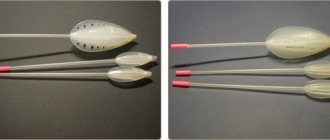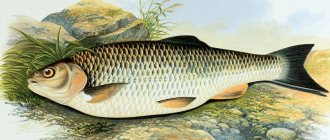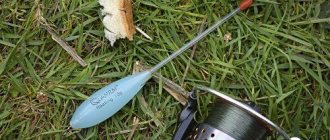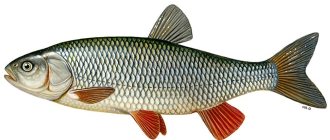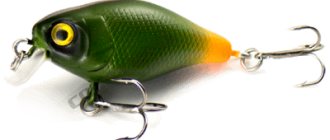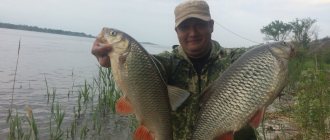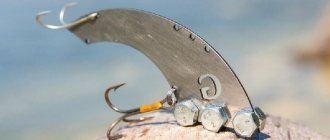Our initial “entry” into the ranks of spinning chub fishermen happened, as they say, from scratch. There was no experience, no “senior” comrades with their timely and kind advice, no already “caught” baits. Everything is based on literature and thematic videos of more successful and “advanced” colleagues in this matter.
That’s why we were pleased with the “full cones”, many mistakes and the long-awaited victory. Yes, a chub is not a freshwater shark - a pike. There is no need to expect greedy and bold strikes, and the retrieves do not take place in “still” water, which is different from the usual perch-pike methods of “giving” the bait.
We identified several typical chub retrieves suitable for “working” in the current and near “streams”, where this handsome river fish likes to be found. Surely they will help beginners who decide to catch chub with a spinning rod and spoon.
Wiring - with the flow
So, the first wiring is with the flow. Otherwise, it is called “experienced” as “upstream”. It seems that this is the most “beginner” type of wiring, easy to master and works everywhere.
Casting the bait, as the name suggests, is carried out above the current. Then we “reel” at a speed exceeding the speed of the current, trying to play with the bait a little. Roughly speaking, the principle at work here is “throw further, turn faster.”
You don’t have to be too fancy with the game, the main thing is that the bait doesn’t go completely “dead”. The advantage of wiring is the natural behavior of the bait. As a rule, the chub stands with its “nose” downstream, waiting for a treat, and therefore “grabs” the bait coming from above much more boldly. In addition, the bite “hits” perfectly in the hand and is visible on the spinning rod.
Catching wiring
Of all the freshwater fish species, my favorite to catch is chub. This is a real opponent who delights with his strength and grace. I catch bluefin mainly from April until the end of September. Every fishing trip is successful. Chub is a plentiful fish, and in all the rivers of the central zone! But despite this, I often meet anglers who say: “I have never caught a chub in my life!” I tried many times, but it doesn’t bite, you bastard...”
There are many articles about chub fishing. Many authors rely on bait. They recommend super catchy wobblers for 1000 rubles, they say that the chub simply tears up such and such a model. Yes, I don’t argue, a lot depends on the bait. But at the same time, nothing depends on her. Those anglers who tried but failed to catch a redfin say that they bought a bunch of wobblers recommended in magazines and the Internet. And still there is no result! The reason, first of all, is the inability to do the correct wiring. Well, in disguise, of course.
I won’t write about camouflage. Many people did this for me. I want to pay attention specifically to the technique of feeding the wobbler to the chub site and the wiring itself. When my passion for chub fishing just began, I caught crankbaits and minnows with my own game using wobblers. The results were inconsistent and often I returned home without fish or impressions. Then I used only one technique of wiring - uniform at a medium pace. Later, when I noticed that the fish often accompanied the bait, but did not attack it, I began to use the techniques of stopping the retrieve or accelerating the reel. I must say that in some cases it worked: the fish following the wobbler grabbed it. The key phrase in the last sentence is “in some cases.” And this means nothing more than that more often the chub simply lost interest in the wobbler.
One day, on the river bank, I met a spinning player. His name was Ivan. He, like me, caught chubs (I immediately understood this from the equipment). I came over to ask how it was going. He opened the basket and I was stunned: there were about six chubs weighing about a kilogram! “I’m letting the little ones go,” Vanya said. That is, these are not all his trophies! At that time I only had 2 redfins weighing about 400-500 grams (which was already a test for me). I started asking him about the wobblers he fishes with, but he immediately interrupted me, saying that it’s not about the bait. The trick is in the wiring. In order not to be unfounded, Vyanya demonstrated everything with his own eyes. He cast the bait 30 meters in the direction of the current and began to slowly release the line so that the wobbler swam under an overhanging bush. Well, this was not surprising - I also presented the bait that way. I thought that he would start dragging the wobbler towards him, but that was not the case! Vanya simply closed the bow and waited. Long, probably a minute and a half. Then he made a few turns and began to wait again. Suddenly the rod shook, Vanya made a hook and after a few tens of seconds he pulled a half-kilogram chub out of the water. There seems to be nothing surprising: the man caught a fish. But no, he knew from the very beginning that this cast would be effective - all his actions were so confident and relaxed! When I was casting, I didn’t have such confidence - only hope for a catch. Of course, my interest awoke. I asked Ivan to explain in more detail what was happening, and he readily agreed...
The whole secret of chub fishing is in the long pause of the bait, when the current plays with the wobbler. It is during this that the bite occurs. You need to keep the bait in place for a very long time: from 30 seconds to 3 minutes. If after 180 seconds there is no bite, you need to slightly pull the wobbler towards you and pause again. Wobblers for such wiring need high-quality ones so that they start even from a very slow current and it is better if they are mini-cranks. You need to buy wobblers that are not very small and only CP ones. The chub also bites on baits with a depth of 30-50 cm, but much worse than on surface models. Probably, the big-headed one in this case perceives the wobbler as a bug that flounders on the surface of the water.
Good wobbler for chub
After I mastered this type of wiring, my catches increased sharply. You can catch chub this way in any warm period of the year. The main thing in such wiring is patience. It’s hard to stand for several minutes, letting the wobbler play in one place. I immediately want to pull it a little, move the tip of the spinning rod. Overcome your restlessness and you will find out what an excellent chub bite is. No tail, no scales.
"For demolition"
The second wiring is “for demolition”. Here the bait is “thrown” at an angle to the current (no steeper than 45 degrees along the current). You can generally cast across the current. We reel in slowly, based on the required depth of the bait and its “drawn away” by the current, preferably “uniformly”.
It turns out that the current works with the bait almost by itself due to its drift. We only visually (by the tip of the rod) or tactilely (by tapping on the palm) control the “game” of the bait.
It’s great to carry out “reconnaissance” of bushes or driftwood with such wiring. Standing above a potentially promising area, we cast, evenly tighten the “cord” and wait for the bait to drift to the “catching” point.
Fishing in the wire
Spring is the most suitable time of year for fishing. This method is attractive due to its unpredictability, since it is impossible to know in advance what will hook you. Typically, fishermen try to catch roaches using this method, but absolutely any fish can bite. You should know that fishing during fishing can be especially successful if the time for fishing is chosen correctly.
The ideal option is to get to the reservoir during the fish run, since this is the best time for fishing. You can ask local residents or experienced fishermen when you need to go fishing; they will always give the right advice. You can decide on the fishing location using a similar method.
If you do not have such an opportunity, then the right action would be to regularly throw the gear to the most promising places in your opinion. Pay special attention to all kinds of obstacles on the pond (large protruding stones, whirlpools, fallen trees). For fishing, you can use either a rod and reel or blind tackle. You need to take a fishing rod no more than 4 meters, equipped with rings and a reel.
For ease of control over the float and bait, it is better to use an inertial reel. A spinning reel is most often needed to make long casts, which are usually not used with this fishing method. Use a stick model as a float.
Read: How to catch crayfish
Wiring - "plop"
The third wiring is “splash”. It is simple, but, unfortunately, ineffective. Everyone knows the chub’s love for picking up various “yummy” things that have fallen into the water in the form of bugs or grasshoppers. Fish especially often “graze” near the bushes and branches hanging over the water.
We try to get the bait closer to such vegetation, simulating a bug falling into the water, and wait for a bite. Of course, most of these drops are zero, and even the resulting bites are “idle”. But the wiring is interesting and simple. It can be combined with “demolition” wiring.
Methods for guiding chub
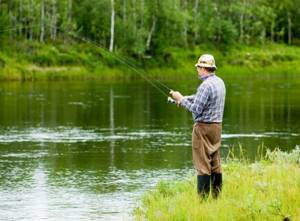
A specific fishing technique when fishing for chub can have a very significant role in the results of fishing.
It is worth throwing the bait slightly away from the expected location of the fish. It is recommended to place the wobbler on the side of the chub, so that the tackle comes unexpectedly into the predator’s field of view. It should also be taken into account that the chub will not chase after elusive prey, especially if it is full. So the ideal option would be to tease him, either stopping him, or slightly tugging him forward, or pushing him back. And when fishing for a “fronthead”, do not forget that this fish is extremely strong, and with a strong tension on the fishing line, it may well break it, so be alert and set the friction brake correctly.
The video below shows the process of catching chub on the river. The wobblers used are demonstrated. The fish are being caught!
Loop-shaped" or simply "loop"
The fourth wiring is “loop-shaped” or simply “loop”. It is also not distinguished by its “confused” implementation and complexity. We do not “slam” the line handler immediately after casting, but only after releasing 10-15 m of the “cord”. Here the current begins to work out, which “presses” on the fishing line and slowly carries the bait along the promising opposite bank.
This wiring helps out in difficult places where branches, etc., prevent the bait from being sent with a regular cast. obstacles. Often, a chub “hits” the bait as it makes a “turn” across the current, but it can also grab it while it’s freely “falling” downstream.
Wiring fishing technique
How does the fishing technique differ from other methods of fishing? A beginner, accustomed to fishing in lakes and having perfectly mastered this skill, always expects that when he bites, the fish will “dip” or “lead” the float. However, during line fishing, fish do not act this way. It is important to know that when fishing this way, the fish does not swallow the bait, but only draws in for a while. If the fish feels the slightest resistance, or, God forbid, a prick from a hook, it will immediately throw out the bait.
Read: Fishing on the makushatnik
When fishing this way, precise loading of the floats and the sharpness of the hooks are important, which will allow you to notice the slightest bite. It is the oscillation of the float that will allow the fisherman to react to a bite with a timely hook. For such fishing, the fishing rod should be small.
If casting the tackle does not produce results, repeat it, first checking the integrity of the nozzle. Secondly, a beginner needs to learn how to cope with the gear when catching fish (especially large ones). There is no need to intercept the line with your hand immediately after catching it. The catch must be kept on the fishing rod for some time and only then brought to the watercraft for lifting.
"Alloy"
The fifth wiring is “alloy”. Suitable for wobbler baits. Ideal for fishing from a spit or bridge. Helps out when the tackle or spinner lacks the “range” of casting. Having thrown the wobbler and released the “cord,” we let it float to the desired place along the current, and then reel it in.
In principle, these are the main “techniques” we have mastered for catching chub with spinner-wobbler baits. There are still a great many variations and combinations of these postings. However, the simplicity of the ones described will probably appeal to you and will help a beginner “get used to” chub hunting.
Andrey Turkin - Especially for the site Fishing: do-it-yourself homemade products, Pervouralsk, Russia, Photo-__FeLiX__(E1.ru)
- The influence of the color of a spinning bait on catchability when fishing for chub
- Equipment for catching large chub in the current
Catching chub reeling 1
Retrieving chub fishing is a widely used method of catching chub throughout the entire period of open water.
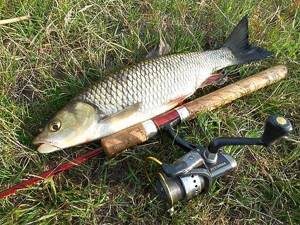
Chub
Depending on the weather, time of day, season, the bait can be placed at the bottom or in half-water, and you can also use a strong or medium current. For example, on warm summer days it is better to catch chub in half-water, and often even at the surface. When it gets colder, it is recommended to place the bait near the very bottom - during this period the fish prefers a calmer current.
When selecting a fishing line, you need to take into account the size of the fishing object, as well as the transparency of the water. Depending on the lighting, it is advisable to use leashes of different colors. They can be blue, green, brown or a combination. Floats, accordingly, can be dark or light colors. It is better to use well-weighted, elongated floats. It would be useful to have with you a set of leashes equipped with hooks of different sizes. Leashes - for their quick replacement - must have a loop at the end. They are attached to a loop made at the end of the main fishing line. It also doesn’t hurt to take with you several floats of different capacities. The best floats are made from polystyrene foam. Recently, especially in shallow water or in overhead fishing, they often began to use a transparent float, which is least noticeable to the fish. Hook, depending on the nozzle, No. 5-10. Scaffolding 0.2-0.25 mm. The leash is long, up to 1 m, with a thickness of 0.15 - 0.2 mm. To quickly sink baits, they usually use a series of successively smaller pellets or olives. The reel used is a regular spinning reel of medium or small size, inertia-free or multiplier. Whether to use a ratchet brake is a moot point, because it is too noisy for such fishing.
When fishing in deep places, with a depth exceeding the length of the rod, a sliding float is installed, and a piece of elastic or a cambric with a wire threaded into it is used as an upper limiter. The nozzle should be 5 - 15 cm from the bottom, but sometimes on rivers with a flat, uncluttered bottom, you can use the nozzle dragging along the bottom. To do this, install a float with a higher carrying capacity. The bottom weight in this case should be at least 40 - 50 cm from the hook.
When releasing the fishing line, you need to make sure that there is no sagging, otherwise you may not be able to hook it in a timely manner. Sometimes, when recasting, they hook “at random”, as the fish sometimes begins to chase and grab the bait that goes up.
In early spring and late autumn, a worm, a bunch of bloodworms, a maggot, a bark beetle larva, small caterpillars, a cockchafer larva, a dragonfly larva are usually baited onto a hook and the bait is placed near the bottom. In summer, vegetable baits are successfully used: steamed peas, wheat, pearl barley, oats, bread pellets, and when fishing in the upper layers of water, large and medium-sized winged insects that are natural for the area are used for bait. Moreover, it has been noticed that bites occur more often when the insect begins to beat the water with its wings. An unusual bait for fishing chub is a piece of cheese.
For long-distance trips in strong currents, you can use a feeder. Usually I put crackers in a fine-mesh net along with cake and porridge. Then I load it with a heavy, small-volume load, tie a long rope to the feeder and throw it to the place I need so that the crumbs washed out by the current float in a strictly specified direction. It is better if you equip such a feeder with a signal buoy. The best option in this case is a rope threaded through a ring attached to the feeder, which is fixed in a tense position by a buoy tied to its end. Release the line and the buoy will float up. It will allow you to find out the location of the feeder. The same feeder is used when fishing from a boat, as well as from ice. She descends like this.
In some cases, when fishing from a boat, you can not load the feeder, but give it the opportunity to float and even move in the current, given that the fishing area will still be at a considerable distance from it. The use of the feeder described above sometimes allows you to keep shy fish in a given area. But still, when fishing for a chub, you have to change places often, so as bait I simply throw in periodically a little unicorm mixed with maggots, or pieces of a compressed mixture of steamed millet and breadcrumbs. In my opinion, the most interesting thing is to catch chubs by placing them on top. This hunt begins from the moment the cockchafer takes flight (usually coincides with the time of bird cherry flowering). They fish on rapids and rifts bordering holes. The bait is directed under overhanging bushes, along aquatic vegetation, past its islands and into fast-flowing channels, towards the ends of drains. You should also not miss the high banks, where the stream of water presses against the cliff.
To collect about two dozen May beetles (Khrushchev), select a medium-sized birch tree at the edge of the forest, spread a raincoat or newspaper under it and shake the tree. Beetles will rain down on the litter. Keep the collected beetles in a spacious box with holes, along with a small amount of birch foliage. Even better if you can get the wicker beetles that feed on the leaves of the coastal willow. They are silver on the inside. The chub is more accustomed to its taste and smell. The honey beetle emerges a little later than the cockchafer. In the summer they catch June and July beetles - varieties of May beetles.
The best method of insertion is as follows: the hook is inserted into the anus, the sting is released into the hard part of the body near the legs. This way the beetle holds tightly and does not break off when thrown. Hard elytra are removed or straightened. The hook tip is brought out.
In May, chub catch throughout the day, but it is especially good to fish at dusk during the flight of the beetle; in the summer it bites well in the morning and evening hours, and when the viburnum fades, the bite weakens. It is advisable to have a small, round or oval float. You don’t have to use a sinker for this fishing, but it’s better to attach a small pellet to the leash, because the chub is more willing to take a submerged beetle. You can fish from the shore, wade or from a boat. In Ukraine, fishing for chub by swimming from a boat is widespread. It involves two fishermen: one sits on the oars, the other casts a fishing rod. But, with some skill, you can try to catch alone. The fishing rod is light and very flexible, preferably a fly fishing rod.
When fishing with blind tackle, a “graft” is used. The conical line is continued by a one and a half meter leash made from fishing line with a diameter of 0.17-0.3 mm. If you are fishing for a cockchafer, it is better to take a large hook No. 8-10, if for a grasshopper - smaller No. 5-8. Sometimes grasshoppers are strung in a bunch, several pieces at once. It is preferable to choose drier and brown grasshoppers: the fish take them more greedily. To prevent the fishing line from sinking, it is lubricated with goose fat, and sometimes a series of small floats made of feathers or foam are used. Going downstream, anglers check the favorite stopping places of chubs.
Sometimes, in order to make several casts to the same place, it is necessary to stop the boat. Then all that remains is to anchor or, holding onto a reed, reed or bush branch, slow down the movement. After the first haymaking, it is good to catch chub using a hawthorn butterfly, grasshopper, locust or dragonfly.
Butterflies and dragonflies are planted one or two at a time from the head, and some of the wings are torn off. Locusts have their legs broken off. When fishing without a sinker, the wind prevents the bait from going downstream. In this case, you need to look for areas where you can use the wind. As they say, what hinders us will help us. Having chosen a place, the angler stands on the windward side and lifts the rod vertically, then releases the fishing line, which allows the wind to carry the bait over a fairly decent distance. In this case, the float and sinkers are not used. In the wind, as already mentioned, the chub becomes less careful. Also, in addition to adult insects, their larvae are used as bait: caterpillars, mealworms, eels, omentums, geese.
A wonderful bait is wasp larvae. They are larger and more tender than maggots. They live in honeycombs, but assembling the honeycombs is quite a difficult task; it requires a lot of skill. It is better to approach a wasp's nest after sunset, when its adult owners have already settled down for the night and are not so dangerous.

For bread
You can't miss the chance to fish with a crust of bread. A piece measuring 10x10 mm or a little larger is placed on a hook and set adrift. Floating crumbs are thrown in to attract fish. Usually a lot of small things collect near the crust, which makes the chub less careful. A float and sinker are not needed here. As a rule, large fish take bait when leaving long distances. A piece of bread weighs enough to easily throw it 15 meters, and then, caught by the current, it will quickly swim to the intended chub site, even if it is located at a decent distance from the fisherman.
Chub fishing in deep water is little known, although it can be very productive. This type of fishing is usually carried out in the summer after long rains. At this time, the water in the rivers rises, drowning aquatic vegetation. It often happens that between water lilies or some other aquatic vegetation and the shore there remains a clean strip of shallow water, where the fry usually frolic. As the river level rises and the current intensifies, the chub comes here to feed. It should be caught in mid-water using a worm, caddis, or goose, letting the float go with the flow.
Sometimes fishing is more successful from steep banks, near which algae often grows on underwater ledges. In such places, the bait must be placed over flooded plants or closer to the shore. Cloudiness of the water after floods allows the angler to sneak closer to the fishing object and use a shorter rod. However, it is more convenient to increase the weight of the sinker and the size of the float of a wire fishing rod.
